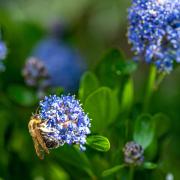Garden designer Jane Follis has recently moved her studio to Ditcheat in Somerset and is looking forward to helping people around the county create beautiful spaces to be enjoyed for many years
Garden Oasis Garden designer Jane Follis has recently moved her studio to Ditcheat in Somerset and is looking forward to helping people around the county create beautiful spaces to be enjoyed for many years.
As our inimitable English summer becomes more than a glimmer at the end of the springtime tunnel, getting out in the garden is more appealing than ever, particularly when the June garden is so full of colour and scent. Whether it’s for a day’s hard work or an ice-cold sundowner, the magnetism of the outdoors is undeniable. Following an unseasonably warm April, the temptation to run amok in the garden centre is almost irresistible. But, as garden designer Jane Follis maintains, time, planning and preparation are our greatest assets in getting the most from the outdoor space we value so much.
Grab a coffee, sit down and take some time to look around your garden and reflect on a handful of important factors. Think about where the sun rises and sets, which plant would suit which space, where to put a bench, a sandpit for the children, a water feature, and a space to grow vegetables. Make a rough sketch – it doesn’t need to be Turner Prize-standard – and then allocate spaces. For instance, a spot of dew on the beautifully delicate leaves of an Acer will be burned by the morning sun if you place them facing east. Equally, it’s vital to consider where the sun sets – this is a lovely place to put a bench to wind down with that evening drink. Even if our summers may not have been living up to their name of late, shade in your garden is imperative. A parasol would do, but what about a beautiful tree that will live well into the future? There are too many to mention here and much will depend on the size of your plot. Research how big they grow before you buy. Similarly, fences could be replaced with hedging for a much softer and more natural look that will outlive their creosoted counterparts by years. Simple solutions like these are effective, attractive and, most importantly, completely natural.
Let’s talk water features. There are plenty to choose from off the shelf, but sometimes the way they deal with form and function is questionable. Why not be innovative and create something different? A popular choice with my clients is a large beehive pot filled with water that trickles down the side. Few things are as calming as the sound of gently running water, particularly on a balmy summer’s eve. Plus, the beehive is safe for children, and makes a brilliant wine cooler for adults. They are simple to install: a water chamber and pump are fitted below ground and the pot sits on a strong mesh sheet. The pump circulates the water whilst pebbles hide the mesh. Provided you can drill a hole through an object – to take the pipe leading to the pump – you could, within reason, use almost anything to create a water feature that’s entirely your own.
"June is almost the best month for the perennial borders, with a riot of colour and scent"
We are all being encouraged to ‘grow your own’ and with good reason: straight-from-the-garden fruit and veg is very hard to beat. The best bit? Getting started is very straightforward: a small, one-metre square raised bed can either be purchased or put together very simply using wood or sleepers. At this time of year it is not too late to start your vegetable patch. Dig over the soil, removing weeds as you go, and then rake over the surface. You need to have a fine, crumbly texture. Using a trowel or a hoe, make a furrow in the soil and then sow the seeds finely in the bottom and cover over with soil. Make sure you label each row, unless you like the element of surprise. Crops to grow at this time of year would be courgettes, beetroot, winter cabbages, French and runner beans, salad crops, turnips and radishes. This list is by no means comprehensive; just have a go and try whatever takes your fancy. Chocolate habanero chillies and watermelon are among my favourites from this year’s more bizarre crops – both gifts from an American client that are thriving in the greenhouse. These are possibly too delicate to grow outside, but do make use of your windowsills for tomatoes and chillies. Remember not to sow whole packets of seeds at a time. If you get 100% germination you may well end up feeding your entire neighbourhood. You can always cheat: many garden centres now sell small plants for you to plant straight into the ground.
The images here show a beautiful walled vegetable I designed in 2010, illustrating the result of a laboured yet fruitful period of renovating and revitalising. The original space was unattractive and completely impractical, with narrow paths that barely took the width of a wheelbarrow. The edging to the beds was a mix of wood and sleepers and the paths were a mishmash of pavers and grass nigh on impossible to mow. The new, 1.2-metre paths use binding gravel that is hard wearing and attractive. The arbour overlooks a small water feature and flower cutting bed, whilst the fruit cage was ordered to fit the triangular bed and lower strawberry cages were also made to fit the beds along the wall. With careful planning this garden enables its owners to be almost self-sufficient throughout the year.
June is almost the best month for the perennial borders with a riot of colour and scent. To keep plants flowering for longer and to encourage new growth, make sure you deadhead them, i.e. remove the flowers that are dying back. Even if it’s every gardener’s bugbear, keeping on top of the weeds is well worth it, and if you didn’t do it earlier this year then it is a good idea to lay mulch on the ground to suppress the weeds and feed the plants. A designer’s trick is to plant perennials in swathes of three, five or any odd number to achieve blocks of colour rather than individual plants vying for attention. Don’t be frightened to fill the earth – it saves on maintenance and weeding, allowing the eye to roam across the borders.
The NGS in June
The garden at Abbey Farm in the historic village of Montacute was started in 1963 and today it provides a stunning setting for the gatehouse of the Cluniac Priory destroyed at the Dissolution of the Monasteries.
Opening in aid of the National Garden Scheme, the 2.5 acre garden is set on different levels and includes a pool garden, a small arboretum, clematis and roses, fine walnut tree and monkey puzzle.
The house is not open but teas will be for sale in the neighbouring church.
Abbey Farm garden, TA15 6UA, is open on 26 and 27 June 2pm - 5pm. 01935 823572 For a full list of NGS gardens open in May visit ngs.org.uk
Jane Follis Garden Design
Jane set up her garden and landscape design practice over fifteen years ago. She works throughout the country on a broad range of projects.
She is a registered member of and adjudicator for the Society of Garden Designers – the industry’s only professional body.
Jane champions a hands-on, personal approach, believing that each garden is an extension and embodiment of her clients as it develops, grows and evolves.
She gets her inspiration from the natural landscape, art, sculpture and texture. Combining these with environmental awareness and sustainable building practice and materials, Jane creates spaces that effortlessly unite form and function.
Have a look at Jane’s garden design projects... www.janefollis.com


























